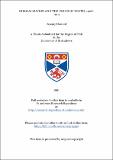Files in this item
Nikolai Kul'bin and the Union of Youth, 1908-1914
Item metadata
| dc.contributor.advisor | Lodder, Christina | |
| dc.contributor.author | Howard, Jeremy | |
| dc.coverage.spatial | 2 v (576 p, 171 p of plates) | en_US |
| dc.date.accessioned | 2018-07-16T14:17:02Z | |
| dc.date.available | 2018-07-16T14:17:02Z | |
| dc.date.issued | 1991 | |
| dc.identifier.uri | https://hdl.handle.net/10023/15432 | |
| dc.description.abstract | The first exhibition organised by Nikolai Kul'bin opened in St. Petersburg in April 1908. It marked the beginning of a new era in the history of the art of the Russian capital, and introduced many young artists to the exhibiting environment and the public. While still firmly within the symbolist tradition it was these artists who strove to renew and broaden the visual language of painting. The aim of this thesis has been to trace the developments in this process that started from fin-de-siecle symbolism and reached, via Neo-Primitivism, a climax in Cubo-Futurism. This is achieved by a survey of the composition and events surrounding Kul'bin's group "Triangle" and the art society that grew out of it, "The Union of Youth", from 1908 to 1914. As a group Triangle existed for three art seasons between 1908 and 1910. Chapters One and Two examine the growth and changes in the group in this time. The adoption of an aesthetic of "free creativity" and synaesthetic principles, the psychological impressionism of Kul'bin and Matyushin, and the association of ideas with literary symbolism are examined. The notion of art as an abstraction from nature is studied with reference to Markov's theories and the art of the Union of Youth exhibitors in Chapter Three and succeeding chapters. In addition, the originality of the establishment of the Union of Youth in the Russian context, and the overlap of ideas and artists with Triangle is discussed. The provision of this new forum for unestablished artists stimulated many developments in the visual arts, not least the progress of Neo-Primitivism, which, as seen In Chapter Four was even transferred to the theatre. The Union of Youth's production of "Khoromnyya Deistva" is seen to presage Markov's notion of "constructive" and "non-constructive" art, examined in Chapter Five, as well as the zaum transrationalism of Malevich, Matyushin and Kruchenykh in the Futurist opera The Victory over the Sun. The Union of Youth's role in creating the ambience appropriate for such ideas is analysed and in the second half of the thesis it is seen that while the group backed these modernist tendencies, most of the member-artists actually failed to be truly innovative in their own art. The dependence on developments in Munich and Paris, and the inter-relationship of these artistic centres with Petersburg are studied in the light of the retention of a mystical symbolist aspect in the art of the Petersburg avant-garde. | en_US |
| dc.language.iso | en | en_US |
| dc.publisher | University of St Andrews | |
| dc.subject.lcc | NX556.U9H7 | en |
| dc.subject.lcsh | Kulʹbin, Nikolaĭ Ivanovich, 1868-1917 | en |
| dc.title | Nikolai Kul'bin and the Union of Youth, 1908-1914 | en_US |
| dc.type | Thesis | en_US |
| dc.contributor.sponsor | British Council | en_US |
| dc.type.qualificationlevel | Doctoral | en_US |
| dc.type.qualificationname | PhD Doctor of Philosophy | en_US |
| dc.publisher.institution | The University of St Andrews | en_US |
This item appears in the following Collection(s)
Items in the St Andrews Research Repository are protected by copyright, with all rights reserved, unless otherwise indicated.

